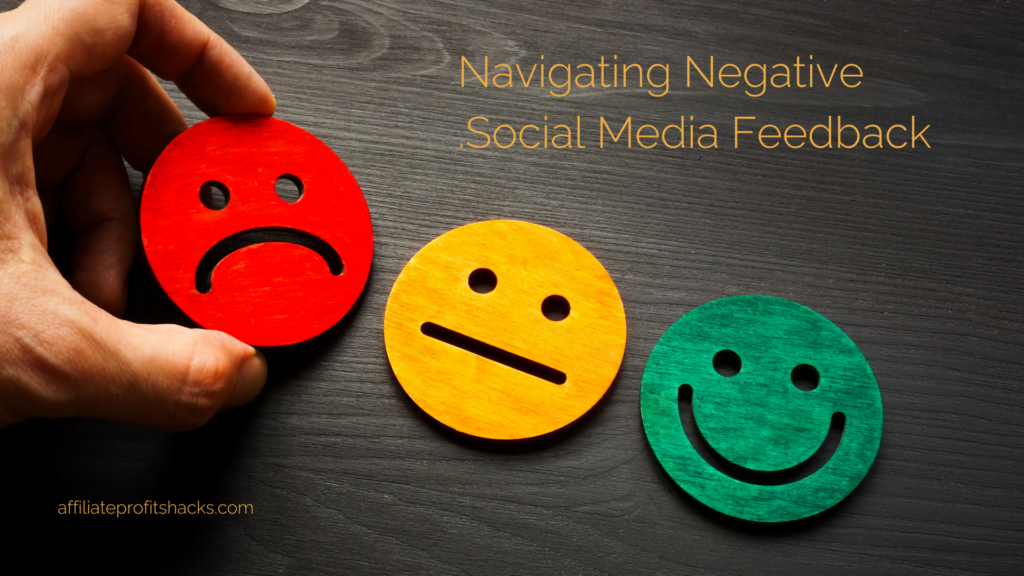Navigating Negative Social Media Feedback
Welcome to my article about navigating negative social media feedback!
Is your brand prepared to handle negative comments and criticism on social media? In today’s digital age, social media has become a powerful platform for consumers to express their opinions about brands and products. While positive feedback can amplify a brand’s reputation, negative comments have the potential to damage it.
When faced with negative social media feedback, brands must have a strategic approach to navigate these challenges effectively. By understanding the importance of responding to negative comments and implementing the right strategies, you can protect your online brand reputation and maintain a positive image.
Wake up to Reality: Good Jobs are Scarce, and Debt is Rampant. Discover How to Secure YOUR Financial Future Against the Odds!

In this article, we will explore the best practices for handling negative comments, the strategies for responding to them, and the tools available to assist you in managing online feedback.
Key Takeaways:
- Negative comments and criticism on social media can impact a brand’s online reputation.
- Ignoring negative comments can harm a brand’s image, it is important to respond to every comment.
- Strategies for responding to negative comments include apologizing sincerely, remaining professional, and personalizing responses.
- Generating more positive reviews can help outweigh the impact of negative feedback.
- Review management tools can assist in efficiently handling and responding to reviews and comments.
The Importance of Responding to Negative Comments
Ignoring negative comments can have a detrimental effect on your brand’s reputation. Responding to every positive, negative, or neutral comment is crucial. By promptly addressing negative feedback and engaging with your audience, you can effectively manage social media crises and maintain a positive online reputation.
Social media has become a powerful platform for customers to voice their opinions and concerns. Failing to respond to negative comments can leave a lasting impression on your audience and hinder your brand’s growth. On the other hand, when you acknowledge and address negative feedback, it shows that you care about your customers’ experiences and are committed to providing excellent service.
Managing online feedback requires careful attention to each comment and proactive engagement on social media platforms. By monitoring comments and direct messages, you can identify issues early on and take appropriate action to resolve them. This proactive approach demonstrates your dedication to customer satisfaction and builds trust with your audience.
Responding to negative comments publicly is an opportunity to showcase your brand’s professionalism and problem-solving abilities. By addressing concerns openly and transparently, you demonstrate that you value customer feedback and are actively working to improve. This level of engagement can turn negative experiences into positive ones and even transform disgruntled customers into loyal advocates.
It is important to remember that not all negative comments are genuine feedback. Trolls, spam, and malicious comments should be dealt with appropriately, following social media platform regulations. By maintaining an active moderation strategy, you can protect your brand’s reputation and ensure a safe and positive environment for your community.
A genuine and timely response to negative comments can turn a potentially damaging situation into an opportunity to showcase your brand’s commitment to customer satisfaction.
Remember, your online reputation is shaped by how you handle negative comments. By prioritizing social media crisis management and actively managing online feedback, you can build stronger relationships with your audience and maintain a positive brand image.
Strategies for Responding to Negative Comments
When it comes to negative comments on social media, how you respond can make all the difference in maintaining your online reputation. You can address criticism, deal with negative reviews, and enhance your social media feedback management by implementing effective strategies.
First and foremost, it’s essential to apologize sincerely for any inconvenience or dissatisfaction the customer expresses. Acknowledging their concerns shows empathy and a commitment to resolving the issue.
Avoid making false promises or over-committing to quick solutions. Instead, focus on providing accurate information and realistic expectations. Transparency and honesty will help build trust with your audience.
It is crucial to remain polite and professional throughout the conversation. Even if the commenter becomes confrontational or aggressive, maintain a calm and respectful tone. Your courteous response will reflect well on your brand and potentially defuse the situation.
If appropriate, shift the conversation to a private channel, such as direct messaging or email. This allows for a more personalized and intimate conversation, away from the public eye. It also demonstrates your commitment to resolving the issue privately and provides a space for open communication with the customer.
Personalize your responses whenever possible. Address the customer by name and tailor your message to their issue or complaint. This personal touch shows that you genuinely care about their feedback and are committed to finding a solution.
Reply Promptly and Explain the Situation
Timely responses are essential when dealing with negative comments. Aim to reply as soon as possible to demonstrate that you value the customer’s feedback and are actively working towards a resolution.
When responding, don’t just apologize or offer generic solutions. Take the time to explain the situation, providing context if necessary. By offering insights into the factors that may have contributed to the issue, you can help the customer better understand the circumstances and foster empathy.
Wake up to Reality: Good Jobs are Scarce, and Debt is Rampant. Discover How to Secure YOUR Financial Future Against the Odds!
We understand that your experience with our product was unsatisfactory. We apologize for the inconvenience caused and want to assure you that we are actively investigating the matter. Our team is committed to resolving this issue and ensuring a seamless experience for all our customers.
By incorporating these strategies into your approach, you can effectively respond to online criticism, address negative reviews, and implement social media feedback management strategies that strengthen your brand’s reputation.
Managing Online Feedback on Social Media
Handling negative social media comments is crucial when managing your online brand reputation. Negative comments can impact your online reputation and discourage potential customers from engaging with your brand. Therefore, it is essential to have effective strategies in place for online feedback management. This section will explore key tactics for managing negative comments on social media platforms.
Creating Engaging Social Media Content
Creating engaging social media content is one way to encourage positive engagement and generate more positive comments. This can include informative and entertaining posts, videos, or images that resonate with your target audience. By offering valuable content, you can increase the chances of receiving positive feedback from your followers.
For example, if you are a fashion brand, consider showcasing your latest collection or sharing styling tips that interest your audience. By providing content that aligns with your brand’s values and interests, you can foster a positive online community and receive more positive comments.
Replying to Positive or Neutral Comments
Acknowledging and responding to all positive or neutral comments on your social media posts is important. Engaging positively with your audience demonstrates that you value their feedback and appreciate their support.
When responding, be sure to use a friendly and conversational tone. You can also incorporate humor when appropriate, as it can create a more engaging and lighthearted conversation with your followers.
“We love hearing your positive feedback! Thank you for taking the time to share your thoughts. We’re glad you’re enjoying our products as much as we do!”
Resolving Conflicts in Private Channels
Negative comments may sometimes escalate into conflicts or require further clarification. Instead of continuing the conversation publicly, shifting the discussion to private channels is advisable. This allows you to address the issue more personally and one-on-one, demonstrating your commitment to resolving the customer’s concerns.
For example, you can respond to a negative comment by acknowledging the issue and offering to continue the conversation through direct messaging or email. This approach demonstrates your willingness to resolve the matter and prevents other followers from witnessing a potentially negative interaction.
Personalizing Messages and Timely Responses
When responding to negative comments, it’s essential to personalize your messages. Address the customer by their name and show genuine empathy towards their concerns. This personal touch can make the customer feel valued and increase the chances of resolving the issue satisfactorily.
Additionally, responding promptly is crucial. Delayed responses can leave customers feeling ignored or unimportant. Aim to reply to negative comments within a reasonable timeframe, ideally within 24 to 48 hours. This demonstrates your attentiveness and commitment to addressing customer feedback.
Implementing these strategies can effectively manage negative comments on social media and protect your online brand reputation. Creating engaging content, replying to positive or neutral comments, resolving conflicts in private channels, and personalizing messages can create a positive and constructive online environment for your brand and its followers.
Lessons from Real-Life Examples
The power of real-life examples cannot be underestimated when handling negative situations and maintaining a positive reputation. By looking at how established brands like Donatella Versace and Delta Air Lines have successfully navigated customer feedback, brands can learn valuable lessons in effective communication and resolution strategies.
Donatella Versace, the renowned fashion designer, provides an excellent example of a sincere apology. When her brand faced backlash for a controversial design, she personally responded with a heartfelt apology, acknowledging the concerns raised by customers. Her genuine remorse and commitment to improvement resonated with the audience, helping to rebuild trust and loyalty.
We deeply apologize for any offense caused by our recent collection. We value the feedback we have received and take it to heart. Your opinions matter to us, and we are committed to addressing the concerns raised. We are actively working to ensure that such instances are not repeated in the future. Thank you for holding us accountable.
Delta Air Lines, a global airline, demonstrates the importance of avoiding false promises and providing practical solutions. In response to a customer’s complaint about a flight delay, Delta Air Lines replied promptly, offered a sincere apology, and resolved the issue by rebooking the customer on the next available flight. This personalized approach showcased their commitment to customer satisfaction.
Wake up to Reality: Good Jobs are Scarce, and Debt is Rampant. Discover How to Secure YOUR Financial Future Against the Odds!
We apologize for the inconvenience caused by the flight delay. Your time is valuable to us, and we understand the frustration this may have caused. We have rebooked you on the next flight, and our team will assist you with any further arrangements. Thank you for your understanding and patience.
These examples emphasize the importance of sincere apologies, avoiding false promises, and remaining polite and professional. Brands must understand that negative situations can become opportunities to showcase their commitment to customer satisfaction. By providing helpful solutions and personalized responses, brands can address concerns effectively and maintain a positive reputation.
The Power of Positive Reviews
Positive reviews hold immense value when managing your online reputation. They can help offset the impact of negative comments and play a crucial role in shaping your brand image. By actively working towards generating more positive reviews, you can create a strong foundation of trust and credibility among your audience.
To encourage customers to leave positive reviews, create engaging content that resonates with them. Deliver value through your products or services and provide exceptional customer experiences that exceed expectations. When customers have a positive experience, they are more likely to share their satisfaction with others.
It’s important to acknowledge and respond to positive comments promptly. This shows your appreciation for your customers’ support and encourages them to continue engaging with your brand. Your prompt and genuine responses demonstrate that you value their feedback, helping you build strong relationships and foster brand loyalty.
We couldn’t be happier with our experience with [Brand name]. Their product exceeded our expectations, and their customer service was outstanding. Highly recommend!
Another effective way to encourage positive reviews is to inject humor into your interactions and content. When appropriate, use wit and lightheartedness to create a memorable customer experience. Humorous interactions can leave a lasting impression and encourage customers to share their positive experiences with others.
Having a higher number of positive reviews can significantly minimize the impact of negative feedback on your brand’s reputation. Potential customers often rely on reviews to make purchasing decisions, and a larger number of positive reviews can boost their confidence in your brand. This, in turn, can positively influence your online reputation and help you maintain a favorable brand image.
By generating positive reviews, responding to customer feedback, and fostering strong relationships, you can effectively manage your online reputation and ensure your brand’s image remains strong and positive.
Tools for Review Management
Several powerful tools are available to effectively manage reviews and monitor your brand’s online presence. Access to review management tools, brand monitoring platforms, and social media analytics can greatly enhance your ability to handle and respond to customer feedback. Here are some notable tools that can help:
Brandwatch
Brandwatch is an advanced social media listening tool that enables you to monitor brand mentions, track conversations, and analyze customer sentiment. With its robust analytics capabilities, you can gain valuable insights into how your brand is perceived and take proactive steps to address any issues.
Google Alerts
Google Alerts is a free tool for monitoring brand mentions across the web. You can receive notifications whenever your brand is mentioned in online articles, blog posts, or discussions by setting up alerts for specific keywords or phrases. This enables you to stay informed and respond promptly.
Ahrefs
Ahrefs is a powerful tool for SEO analysis and provides valuable insights for brand monitoring. It allows you to track backlinks to your website, monitor brand mentions, and analyze your competitors’ online presence. By utilizing Ahrefs, you can stay ahead of the game and make informed decisions.
SocialPilot
SocialPilot is a social media management tool that offers various features to streamline your brand’s social media presence. It allows you to schedule posts, engage with your audience, and monitor comments and messages across multiple platforms. Using SocialPilot, you can efficiently manage your social media channels and respond to customer feedback.
Studicus
Studicus is a platform that offers comprehensive brand monitoring and review management services. With its advanced sentiment analysis tools, you can gauge customer sentiment and track the impact of your brand’s reputation over time. Studicus provides valuable insights for improving your online presence and addressing customer concerns.
By using these review management tools, brand monitoring platforms, and social media analytics, you can effectively handle and respond to reviews and comments. These tools provide valuable data and insights that can assist you in maintaining a positive online reputation and strengthening your brand’s image.

Creating a Communication Policy for Negative Comments
When managing negative comments on social media, having a well-defined communication policy is essential for brands. This policy outlines the guidelines for effectively responding to negativity and maintaining standards for customer engagement. By establishing a clear framework, brands can ensure consistency and effectiveness in social media communication.
Wake up to Reality: Good Jobs are Scarce, and Debt is Rampant. Discover How to Secure YOUR Financial Future Against the Odds!
One important aspect of a social media communication policy is setting expectations for response time. Timely responses show customers that their concerns are being acknowledged and addressed. Aim to respond to negative comments reasonably to demonstrate your commitment to customer satisfaction.
Another key element is knowing when and how to apologize. When a customer expresses dissatisfaction, an apology can go a long way in diffusing the situation. Acknowledge their concerns sincerely and show empathy towards their experience. A genuine apology can help build trust and improve the overall perception of your brand.
When a dialogue becomes more complex, taking the conversation to a private channel is advisable. This approach allows for a more personalized and focused interaction, avoiding a public escalation of the issue. Responding privately demonstrates your commitment to resolving the issue and maintaining the customer’s confidentiality.
Appreciating feedback, even negative, is an essential component of effective communication. Let your customers know that their opinions and experiences are important to you. By responding to negative comments with gratitude for their feedback, you show that you value their input and are committed to improving your products or services.
Ultimately, a communication policy should emphasize the importance of offering solutions. Responding to negativity includes more than just acknowledging the problem; it also involves identifying ways to resolve it. Provide relevant information, alternatives, or a plan to rectify the situation. By offering solutions, you demonstrate your dedication to customer satisfaction and showcase your brand’s commitment to excellence.
Having a well-defined communication policy helps brands navigate negative comments on social media effectively and maintain standards for customer engagement.
By implementing and consistently following a communication policy, brands can effectively manage negative comments on social media. This approach ensures prompt, empathetic, and solution-oriented responses. Building a reputation for responsive and professional customer engagement can contribute to a positive online brand image.
Key Points:
- Establish a clear social media communication policy to guide responses to negative comments.
- Adhere to set response timeframes to demonstrate dedication to customer satisfaction.
- Apologize sincerely and empathetically when necessary.
- Shift conversations to private channels when appropriate for personalized resolution.
- Show appreciation for feedback, even when negative, to highlight the value placed on customer opinions.
- Offer relevant solutions to address customer concerns and demonstrate commitment to excellence.
Dealing with Different Types of Negative Comments
Not all negative comments on social media are created equal. Each type requires a different approach for effective management. Let’s examine how to handle various types of negative comments.
Customer Complaints
Customer complaints should always be responded to promptly and with empathy. Acknowledge their concerns and offer personalized solutions to address the issue. You can turn a dissatisfied customer into a loyal advocate for your brand by showing genuine concern and providing helpful resolutions.
Trolling Comments
Trolling comments are often made to provoke and stir up negative emotions. In most cases, these comments are best ignored. Engaging with trolls can often escalate the situation and give them the attention they seek. Instead, focus on prioritizing genuine feedback and meaningful conversations.
Spam and Harassing Comments
Spam and malicious comments have no place in constructive discussions. It’s important to promptly delete any spam or harassing comments from your social media channels. Keeping your online space clean and respectful can create a safe environment for your audience to engage with your brand.
Note: Genuine complaints should not be deleted but addressed and resolved.
Threatening Comments
If you encounter threatening comments on your social media platforms, taking them seriously is crucial. Report these comments to the appropriate authorities or platform administrators. Swift and appropriate action can help protect your online community and ensure the safety of your audience.
Dealing with different types of negative comments requires a careful and tailored approach. By understanding the nature of each comment and responding accordingly, you can effectively manage your brand’s reputation and maintain a positive online presence.
Conclusion
Navigating negative social media feedback can be challenging but with proper handling and effective social media management, brands can successfully manage their online reputation and maintain a positive image.
One key strategy for handling negative comments is promptly and professionally addressing customer concerns. By acknowledging feedback, apologizing when necessary, and providing helpful solutions, brands can show their commitment to customer satisfaction.
Utilizing the right social media management tools and monitoring reviews is also crucial. Tools like Brandwatch, Google Alerts, Ahref, SocialPilot, and Studicus can assist in tracking brand mentions, analyzing sentiment, and scheduling social media content.
Wake up to Reality: Good Jobs are Scarce, and Debt is Rampant. Discover How to Secure YOUR Financial Future Against the Odds!
Ultimately, by building positive relationships with customers and consistently engaging with them, brands can navigate negative feedback and continue to grow their online presence. Handling negative comments effectively improves the brand’s reputation and strengthens customer loyalty and trust.
Thank you for reading my article “Navigating Negative Social Media Feedback.” I hope you found it informative and helpful!
For more insights into Crisis Communication, read this article: Crisis Communication: Protecting Your Brand Online.






